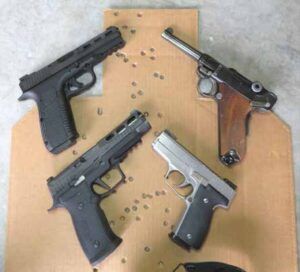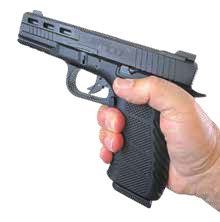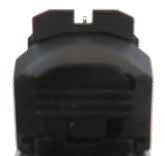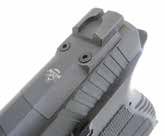What? Metal-frame striker-fired pistols? Think about that for a moment; metal-frame pistols are slowly disappearing. Sure, the 1911 platform uses a metal frame, and so do other older hammer-fired designs from SIG, Beretta, and CZ, but nearly every striker-fired pistol uses a polymer frame. Gun nuts did a double take when Rock Island Armory (RIA) debuted the STK100 striker-fired 9mm in 2021. It looked like just another Glock clone, except for one significant design difference. The STK100 uses an aluminum frame. There are other features that make this Philippine-made pistol stand out, but the metal frame is unique. This sent us on a quest for metal-frame striker-fired 9mm pistols. Are these guns just unicorns, or are there others available to buy?
We tested the Walther Q5 Match Steel Frame a few years ago and thought the steel frame helped mitigate recoil and allow for a fast follow-up shot. But that was a competition pistol, not a defense pistol. One gun that came to mind was the Kahr K9. Kahr built its reputation on the compact metal-frame K9 pistol, so we acquired a Model K9, which features a stainless-steel frame and smooth trigger-cocked striker-fire mechanism.

Another gun is the new metal-frame variant of the SIG P320 called the P320 AGX Pro. As you may recall, the P320 pistol system allows the user to drop the trigger mechanism into any size polymer frame, and now a metal frame as well.
It’s usually interesting to know where gun designs originate, and here, the original 9mm metal-frame striker-fired pistol is a Luger P-08. As you know, the 9mm cartridge debuted with the P-08. While the P-08 in its day was an effective weapon, they are expensive and finicky with ammo. Luckily, one of our staff has a Luger, an Interarms P-08 model, and we wanted to experience the original P-08 and put it into context with current guns, so we ran an the Interarms during the test, but we concentrated our evaluation on the modern variants.
While they are all striker-fired, the trigger design was different on all four, and all felt different when firing. The P-08 uses a pre-cocked striker, so it is actually a single-action trigger pull, similar to the XD models made by Springfield Armory. The other three guns have a longer double-action trigger pull. RIA and SIG pre-load the striker, so there is a bit of mushiness in the trigger. The Kahr uses a trigger-cocking DAO that is super smooth and has a super-long stroke.
We also wanted to judge if the added weight a metal-frame pistol provides is a net pro or con. Does a metal frame help with recoil control? How does the pistol balance in hand? Does it make the pistol more difficult to carry concealed?
We fired both training rounds and defense rounds with different bullet weights and types to see if a pistol favored one cartridge over another. Ammo included Defender 115-grain full metal jackets, Armscor 124-grain FMJs, and Remington Golden Sabers with 147-grain bonded jacketed hollow points.
We tested for accuracy using our range bag as a rest, then ran a Mozambique Drill (also called a Failure Drill) at 10 yards — two to the body and one to the head — on cardboard silhouettes to evaluate ease of use in speed and precision shooting. We also fired a Failure Drill at 5 yards, starting at low ready, and all three shots must be fired between 3 and 4 seconds. In the end, we experienced four very different 9mm metal-frame striker-fired pistols.
Gun Tests Grade: A- (BEST BUY)
$489
Out of the box, the STK100 has a lot going for it. It has a great trigger, comes optics ready, features a low bore axis, produces decent accuracy, and is compatible with some Glock Gen3 mags. It is also reasonably priced, reliable, and it did not rattle apart.
| Action | Semi-auto, short recoil-operated locked breech, striker fired |
| Trigger | Double action only |
| Overall Length | 7.9 in. |
| Overall Height | 5.1 in. |
| Maximum Width | 1.2 in. |
| Weight Unloaded | 30.0 oz. |
| Weight Loaded | 37.3 oz. |
| Barrel | 4.5 in.; 1:16 twist |
| Capacity | 17+1 |
| Slide | Parkerized steel |
| Slide Retraction Effort | 19.0 lbs. |
| Frame | Black anodized aluminum |
| Frame Front Strap Height | 2.4 in. |
| Frame Back Strap Height | 3.6 in. |
| Grips | Textured aluminum |
| Grip Thickness (Maximum) | 1.2 in. |
| Grip Circumference (Maximum) | 5.8 in. |
| Front Sight | White dot front |
| Rear Sight | Fixed notch rear; optics ready |
| Trigger Pull Weight Single Action | 5.9 lbs. |
| Trigger Span Single Action | 2.9 in. |
| Magazines | 1; polymer |
| Safety | Trigger, drop safety |
| Telephone | (775) 537-1444 |
| Warranty | Limited lifetime |
| Made In | Philippines |
| Website | Armscor.com |
Pick it up and you expect the heft of a lightweight polymer gun, but the all-metal frame makes the pistol heavy. It weighs 30 ounces unloaded, a few ounces more than a typical full-size polymer-framed striker-fired pistol. RIA manufactures the frame in two pieces, sandwiches them together, and bolts them with six screws on the right side of the pistol to keep the halves together. You can barely see the seam between the two frame halves. The locking block, trigger, and trigger housing pins, typically found on a Glock, are three slotted screws on the left side of the frame. The screws look a bit odd since we are accustomed to pins in polymer-frames striker-fires.

The second thing we noticed was the grip angle. The STK100 grip is closer to the grip angle of a 1911 pistol. Kudos to RIA for designing the grip like a 1911 with the ability to use Glock magazines. We really liked the balance of the STK100 in hand.
The frame sports a Picatinny-style rail on the dust cover. The trigger guard is oblong and shaped like a 1911 trigger guard, but it is tucked up so you can get a higher grip on the pistol. A nice beavertail also aids in getting a higher grip and protects from slide bite. Side grip panels and front and rear grip straps have an assortment of textures that could work better when securing your shooting hand grip and in recoil recovery. The side-panel texture is excellent, but the front and rear grip straps are a bit slick. We wanted better texture on those surfaces.
The non-reversible magazine release sticks out from grip panel, and when pressed, confidently dumps a magazine. We would have liked the button to be a bit larger. Some of our average-size-hand evaluators needed to shift their grips to press it.

The slide release looks a lot like an oversized factory Glock slide release. It is protected by a ridge in the aluminum frame, and it falls under the thumb of a right-handed shooter. While the controls of the STK100 mirror a Glock, so, too, does the take-down method. The take-down tabs stick out of the sides of the frame, and you pull them down to field-strip the gun. It took some effort to pull down on the tabs, but eventually we were able to slip the slide assembly off the frame. The metal trigger features a familiar Glock-like safety lever in the center of the shoe.
On the top side, the slide has coarse rear and forward serrations that make racking the slide and doing a press check easy. There are also three oblong slots on the left and right sides of the slide to lighten it. The top of the slide has a longer trapezoidal slot. The weight-reduction cuts on the slide mass, and most of the pistol’s heft rests just above your grip when loaded. In addition to reducing the mass of the slide for more manageable recoil, this gives the pistol good balance and quick handling and, in our opinion, rakish good looks. The ejector serves as a loaded-chamber indicator.

The front sight was a steel post with a white dot. The rear sight was part of the optics-mount cover plate, and it featured a notch. There was no ability to adjust the rear sight. We thought this was suspect at first, but we found the STK100 shoots to point of aim at 15 yards. The mounting footprint will except a Vortex Venom, Crimson Trace CTS-1250, or similar-footprint red dot.
The slide-to-frame fit was tight with no wiggle. When we field-stripped the STK100, we found the frame rails were longer than the typical Glock rails, and that helps with less wiggle. The recoil guide rod was steel and used a flat-wire spring.
We tried a G17 Gen3 barrel in the STK100 slide, and it fit, but it wouldn’t slide onto the frame. So while the Glock magazines are compatible with the STK100, other aftermarket parts are not. Note that we could fit the STK100 into a Glock G17 holster.
The 4.5-inch barrel is rifled with a 1:16-inch twist, which is a departure from the normal 1:10-inch twist rate in 9mm pistols. The 1:16 twist favors lighter bullets like the 115 grain to stabilize at higher velocities. Heavy and slow bullets may not stabilize with the 1:16-inch twist rate. We ran 115-, 124-, and 147-grain bullets, and they all provided good accuracy. In fact, our best five-shot group was with the Remington Golden Sabers, whose 147-grain BJHP bullets went into a measured 1.30 inches. The second best was with Defender 115-grain FMJs that measured 1.49 inches. The best group with the Armscor ammo measured 1.88 inches. If you reload heavy bullets at slow speeds, we suspect you may experience key-holing because the 1:16 twist won’t stabilize the bullet.
We thought the white front-sight dot was serviceable, and the rear notch was wide enough for defensive and fast shooting. We would like the ability to use tall iron sights as a backup to a red dot if we mounted one.
If you are familiar with a Glock, you will know how to operate the STK100. At the range, we found that the slide offered a nice recoil pulse, and there was not a lot of muzzle flip due the low axis. For those more familiar with a 1911, the frame made this a natural pointer. The trigger was familiar and better than a factory Glock. There was some take-up and then a somewhat less mushy break that’s typical with Glock-style triggers.
Reloading was fast due to the tapered Glock-style double-stack magazine provided with the STK100, which was made by KCI. We ran a 21-round MagPul PMAG and OEM Glock Gen3 mags with no issues feeding. The OEM Glock mag did not fall free when we pressed the magazine release. We needed to extract it even when it was fully loaded with 17 rounds. We ran the STK100 hard, and it took it all in stride, with no issues. We really like how this pistol shoots.
Our Team Said: The extra weight from the metal frame gives the user of STK100 faster recovery from recoil. We like the ability to use Glock Gen3 mags. Perhaps the best feature was the grip angle. We’d add some skateboard tape to the front and rear grip strap. This is a best Best Buy based on the RIA’s performance and cost.
9mm Luger Range Data
| Defender Remanufactured 115-grain FMJ | RIA STK100 | SIG Sauer P320 AXG Pro | Kahr K9 | Interarms P-08 Luger |
| Average Velocity | 1115 fps | 1153 fps | 985 fps | 1114 fps |
| Muzzle Energy | 318 ft.-lbs. | 340 ft.-lbs. | 248 ft.-lbs. | 317 ft.-lbs. |
| Smallest Group | 1.49 in. | 0.90 in. | 1.55 in. | 2.05 in. |
| Average Group | 1.59 in. | 0.96 in. | 1.72 in. | 2.36 in. |
| Remington Golden Saber 147-grain BJHP | RIA STK100 | SIG Sauer P320 AXG Pro | Kahr K9 | Interarms P-08 Luger |
| Average Velocity | 1014 fps | 1016 fps | 900 fps | 1013 fps |
| Muzzle Energy | 336 ft.-lbs. | 337 ft.-lbs. | 264 ft.-lbs. | 335 ft.-lbs. |
| Smallest Group | 1.30 in. | 0.65 in. | 2.45 in. | 1.50 in. |
| Average Group | 1.52 in. | 1.40 in. | 2.69 in. | 1.51 in. |
| Armscor 124-grain FMJ | RIA STK100 | SIG Sauer P320 AXG Pro | Kahr K9 | Interarms P-08 Luger |
| Average Velocity | 1067 fps | 1090 fps | 910 fps | 1068 fps |
| Muzzle Energy | 314 ft.-lbs. | 327 ft.-lbs. | 228 ft.-lbs. | 314 ft.-lbs. |
| Smallest Group | 1.88 in. | 1.65 in. | 2.00 in. | 1.62 in. |
| Average Group | 1.84 in. | 1.85 in. | 2.13 in. | 1.64 in. |
Value Guide: 9mm Luger Handgun Rankings
| Gun Name | Issue | Grade | Comments |
|---|---|---|---|
| SIG Sauer P365 365-9-BXR3 9mm Luger, $599 | Dec. 2021 | A | Our Pick. Small enough to fit in a pants pocket. Carries 10+1. Felt recoil is less than with a 38 Sp. |
| Ruger MAX-9 No. 3500 9mm Luger, $544 | Sep. 2021 | A | Our Pick. This is a sophisticated pistol. No fault with the magazines, capacity, or general accuracy. |
| Smith & Wesson M&P9 Shield Plus 13246 9mm Luger, $553 | Sep. 2021 | A | A step up from a previously 9mm Shield. The new pistol has an improved trigger and greater capacity. |
| Taurus GX4 1-GX4M931 9mm Luger, $398 | Sep. 2021 | A- | Best Buy. The Taurus is the most compact, and the Taurus is the only pistol with a changeable backstrap. |
| Smith & Wesson M&P9 Shield EZ 12437 9mm Luger, $479 | Feb. 2021 | A- | The Shield EZ9 was easy to manipulate and soft to shoot, but the sights needed to be calibrated better. |
| KelTec PF9 Blued-Black 9mm Luger, $358 | Feb. 2021 | B+ | An inexpensive pistol that functioned flawlessly. It reminded us of a good 38 Special snubbie. |
| Taurus G3C 1-G3C931 9mm Luger, $306 | Feb. 2021 | B+ | Best Buy. The Taurus G3C pistol is an inexpensive offering that functioned flawlessly and shot well. |
| Springfield Armory Hellcat HC9319BOSP 9mm Luger, $550 | Mar. 2020 | A | Our Pick. An 11+1 pistol, this small Springfield might be the most versatile pistol in the group. |
| Walther PPS M2 2805961 9mm Luger, $649 | Mar. 2020 | A | Best Buy. A smaller pistol with grips that will not abrade tender hands. |
| Ruger Security-9 Compact Model 3818 9mm Luger, $309 | Feb. 2020 | B | The pistol is adequate for the task of self defense and will not break the bank. |
| SIG P365 Nitron Micro-Compact 9mm Luger, $465 | Feb. 2020 | B | The SIG costs more than the Ruger Security-9 without overwhelming advantages. |
| Springfield Hellcat Micro-Compact 9mm Luger, $500 | Jan. 2020 | F/A | Hellcat #1 failed when the trigger wouldn’t reset (F). Hellcat #2 worked perfectly (A). Best accuracy. |
| Glock 43X Ameriglo Night Sights PX435SL301AB 9mm Luger, $542 | Jul. 2019 | A | Our Pick. Firing grip is superior to the G43 and allows better shooting with little compromise. |
| Mossberg MC1sc 89001 9mm Luger, $365 | Jul. 2019 | A- | Best Buy. The Mossberg 9mm gave up little to the Glock designs. Reliability was never a question. |
| Taurus G2S 1-G2S931 9mm Luger, $204 | Nov. 2018 | A | Best Buy. The Taurus pistol was reliable and controllable in rapid fire. |
| Smith & Wesson M&P9 Shield SW180021BW 9mm Luger, $400 | Nov. 2018 | A | The Battleworn Shield is reliable, accurate enough, and compact enough for EDC. |
| Bersa BP9MCC 9mm Luger, $295 | Nov. 2018 | A- | Reliable, feels good in the hand, and offers excellent handling in fast-paced drills. |
| Honor Defense Honor Guard HG9SCF FIST 9mm Luger, $400 | Nov. 2018 | A- | The FIST option is viable. We tested it against barricades with excellent results. |
| Ruger EC9s 3283 9mm Luger, $231 | Nov. 2018 | B- | Most accurate handgun of the test, despite its light weight. |
| Kimber Micro 9 Desert Tan (LG) 3300168 9mm Luger, $659 | Oct. 2017 | A | The laser grip complements the large sights on this micro pistol. Edges are smooth for concealed carry. |
| SIG Sauer P938 Emperor Scorpion 9mm Luger, $639 | Oct. 2017 | A | With large sights, a crisp trigger and toothy grips, this was easy to shoot and control. |



























Last time I checked , the ONLY optic that would fit was the Vortex Venom
And the 10 round mags from KCI ? Most will only accept 9 rounds, some only get to 6 and bind up.
I wish you guys would test the unfriendly state guns too.
First off let me say That I’ve owned over 100 handguns. This one is in the top 10 WORST! The optic cut even in the later model (which I have) still isn’t long enough to fit most optics. I had to take a Dremel to my 507K to get into the cut! The checkering on the front and back of the grips might as well not be there. I wound up sliding a Hogue rubber sleeve over mine to stop my hand from sliding. When you ask what twist rate the barrel has you get a different answer from different people at Armscor. Apparently they don’t even know their product. I should just dump this thing but I’m going to try and save it by having a match grade barrel fitted to it to improve accuracy and a 6# striker spring added to get rid of a well known problem with light primer strikes. I haven’t tried to open the frame but I’ve been hearing about screws backing out or the opposite of heads stripping when people try to swap out some parts for upgrading. That’s another thing, approx. 70% of the parts are Glock compatible according to Martin Tuason the CEO of Armscor but you have to guess which ones and waste money trying to find out!